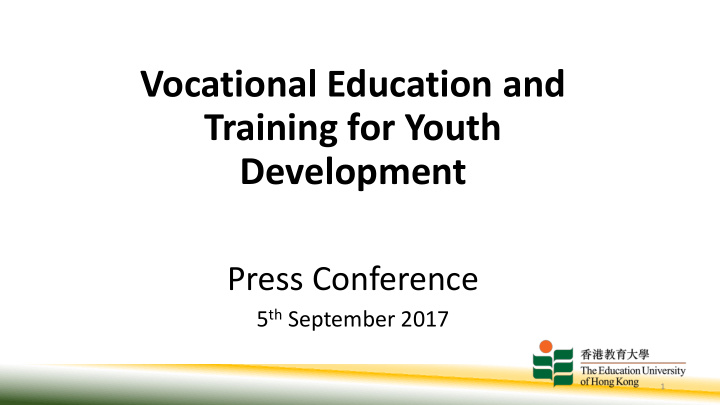



Vocational Education and Training for Youth Development Press Conference 5 th September 2017 1
Background • Skill mismatch • Aging population • Many still consider vocational education an inferior choice for students 2
Objectives • To discuss the role and problem(s) of vocational education and training in the current education system in Hong Kong • To analyze the success factors of vocational education in different regions through a literature review • To discuss ways of developing vocational education in Hong Kong 3
Methodology Case study Survey In-depth Focus group interview • Secondary school • Finland • Telephone poll student (4 groups) • Singapore • 87 participants (parents): 1004 • Students studying (Including in-depth • UK vocational education • School survey: interview and Focus courses (2) group interview) • Taiwan • Parents: 695 • Parents (2) • Stakeholders in vocational • Front-line career and • Students: 794 education life planning teachers (1) 4
Limitations • General participants are likely to be less knowledgeable about VET • Only 8 secondary schools were surveyed 5
Definition of VET • Education and training which aims to equip people (below 30-year old) with knowledge, know-how, skills and/or competences required in particular occupations or more broadly on the labour market. • Ideally, VET should 1) be able to meet the manpower need of the economy; 2) be able to offer multiple pathways for young people; and 3) be recognized by the society. 6
Case studies Success factors Failure factors • focus on employability • overexpansion of higher education • lack of recognition of qualifications • stable financial support • Inconsistent policies • opportunities to articulate into degree- • Unclear positioning level study • effective promotion • declining fertility rates • clear positioning 7
Development of VET in Hong Kong • The HK government established the Vocational Training Council 1982 • Proposal to increase the number of universities 1989 • Prevocational schools progressively transformed their curriculum and moved closer to generic education 1997 • The HK government set up a task force with a view to mapping out a strategy to promote vocational education 2014 8
Analysis-1. Lack of recognition Knowledge about PVET (school Knowledge about PVET (school Knowledge about PVET student survey) parent survey) (telephone poll) Don’t know/Hard to say 4% Yes 32% Yes 31% No 57% Yes 39% No 68% No 69% 9
Analysis-1. Lack of recognition • Less than 20% of the respondents recognized VET as a professional qualification • Nearly 20% of student respondents thought that vocational education is for those who do not do well in the DSE 10
Analysis-1. Lack of recognition • Many parents and students do not see studying vocational education as their first priority • Respondents do not agree that vocational education is equivalent to university education 11
Analysis-2. Limited understanding of the connection between vocational education and qualification framework Knowledge about QF (parents) Knowledge about PVET (students) No 40% No Yes 51% 49% Yes 60% 12
Analysis-2. Limited understanding of the connection between vocational education and qualification framework • Students in focus groups indicated that they had little understanding of the functions of the QF or the relationship between the QF and vocational education • More than half of the parents in the focus groups did not know about the QF and knew very little about its functions 13
Analysis-2. Limited understanding of the connection between vocational education and qualification framework • Students were more interested in new occupations such as pastry chef, interpreter of tarot cards, or wedding planner, while the parents favoured traditional choices such as lawyer, architect, accountant, doctor, disciplined service officer, and engineer 14
Analysis-2. Limited understanding of the connection between vocational education and qualification framework • Experienced educators suggested that traditional vocational secondary schools and prevocational schools were neither famous schools nor schools that achieved outstanding results in public examinations. As a result, the image and recognition of vocational education among the public is not good. • Professionals and employers have commented that the traditional mindset of emphasizing academic qualifications is still obvious. Parents’ resistance to vocational education has led to a reduction in children’s interest in this option. 15
Analysis-3. Human resources mismatch • Although the Hong Kong Government is working hard to promote “ABC occupations” (Airport, Building, and Care), the school survey revealed that the students were not interested in these occupations and had no intention of joining them. • The results from the focus groups showed that employers urgently need to attract young people to join their industries so as to resolve the current staff shortage problem. • In the interviews, employers and advocators indicated that the government lacks a long-term economic plan, and this puts vocational education in a disadvantageous position in Hong Kong’s narrow economic structure. • The government should establish a vision for future economic development so that Hong Kong society can invest more resources accordingly in order to motivate students to join certain industries to meet market needs. 16
Summary of findings • Most of the respondents do not recognize VET as a professional qualification • The general perception of vocational education, which is also entrenched in the minds of parents and students, is that it is an inferior choice for students. • There is a need to establish a professional image of vocational education. Apart from rebranding, related policies must also be implemented. 17
Summary of finding • The current education and training system should be reformed to resolve the problem of human resource mismatch • Articulation between VET qualifications and academic programmes should be improved. • The government could strengthen the recognition of vocational education and the QF in order to raise the professional image of different industries. 18
Recommend
More recommend